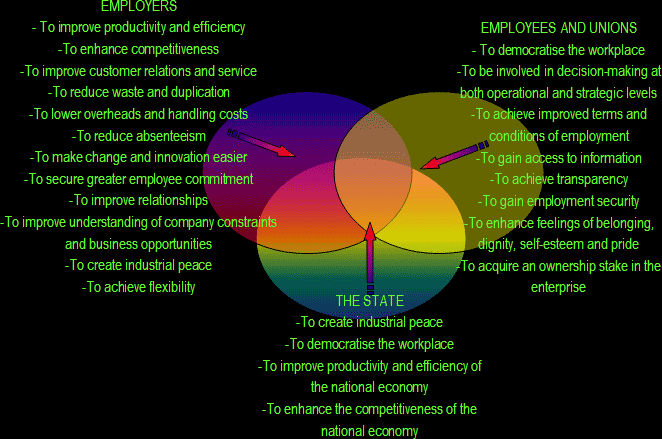|
WHAT IS EMPLOYEE PARTICIPATION?
Employee participation is a process which recognises the need of employees to influence
organisational decision-making on matters that may affect them. It can assume various
forms of interaction with employees and may range from consultation and information-sharing
on the one hand, to co-determination on pre-determined matters on the other.
There is usually a wide range of reasons for embarking on an employee participation
process. Typical examples are:
- Improved productivity, business results and competitiveness
- Improved policy decision-making processes
- Ownership for and successful implementation of policies and procedures
- Legitimacy of governance
- Augmenting the capacity of ‘future decision-makers’
- Employment equity and skills development legislation and processes
The King Report notes that corporations should evolve their own system of worker participation whether by way of worker’s committees or at management, executive committee or board level.
The system of worker participation in governance decisions should grow out of the nature of the corporation’s business, the culture of the corporation, the culture of management and the workers’ organisation.
(King, Mervyn E, et al, "The King Report on Corporate Governance", Institute of Directors of Southern Africa: Johannesburg, November 1994.)
Being the opposite of unilateral or autocratic decision-making, employee
participation is a process where the views of intended ‘beneficiaries’ are taken
into account and in fact form part of the ‘solution’. This also contributes towards
the internalisation of the goals and objectives associated with the desired ‘end
state’.
The creation of a vehicle to manage a participation process is aimed at implementing
a regulated mechanism where the ‘hearts and minds’ of employees are utilised to
typically contribute towards improved policy decision-making processes. This should preferably be based
on a system of co-created values and definitely on shared ownership for the initiative
as a whole.
The divergent and possible convergent interests of the primary parties involved
in an employee participation process is reflected in the following diagramme developed
by Knudsen (1995).
|







